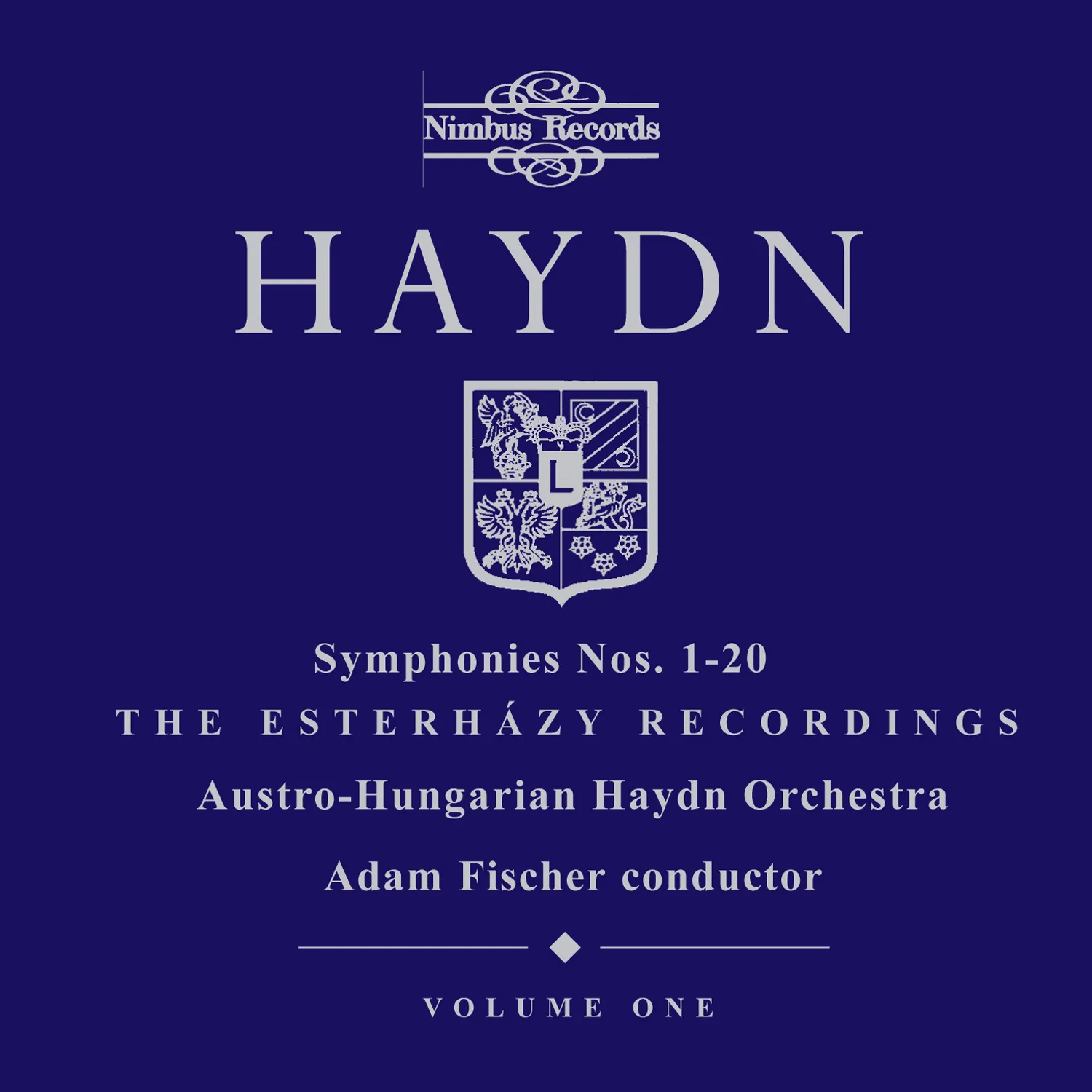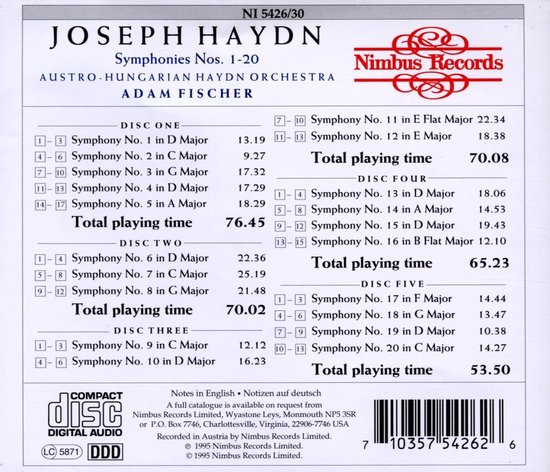This entry will be more of a recollection of the first twenty symphonies by Haydn, as I go through the Brilliant Classics set from Ádám Fischer and the Austro-Hungarian Haydn Orchestra. Find my thoughts on the individual CDs in the Composers section under Haydn.
What is most interesting for me as a listener, is how each work has a strong point, or points, of interest. Not one single symphony passed me by as something to disregard or leave me feeling like Haydn didn't have something to say. Nor did I ever feel a sameness or rote blueprint to Haydn's creations.
Sure, some moments are more memorable than others, but I guess that is the point of this blog; to capture moments, large or small, for further listening pleasure and discovery. This provides me a springboard to explore even more in the future.
I also like to track a composer's compositional progress. This is difficult for Haydn's early symphonies, for the numbering in the Hoboken catalog is not necessarily chronological. In these first twenty symphonies, there is a mix written for Count Morzin and some for Prince Esterházy; some written with three movements and others with four; a few which begin at a slow tempo and many more starting uptempo. Let's do a little 'by the numbers' labor:
Employ
Count Morzin: Twelve (1-5, 10-11, 15, 17-20)
Princes Esterházy:
Three (6-8 for Anton)
Three (12-13, 16 for Nikolaus)
Unsure: Two (9 & 14)
Count Morzin: Twelve (1-5, 10-11, 15, 17-20)
Princes Esterházy:
Three (6-8 for Anton)
Three (12-13, 16 for Nikolaus)
Unsure: Two (9 & 14)
The aspect of who Haydn's employer was becomes important when looking at the resources the composer had at his disposal, as well as the abilities of whom he worked alongside. As to Symphonies 6 - 8, the occasion for which the symphonies were written also becomes rather important. Haydn provides programmatic subtitles to these three symphonies, including an additional single-movement titled 'La Tempesta', which evokes a Classical-Era storm.
Movements
Three: 10 (seven for Count Morzin)
Four: 10 (five for Count Morzin)
Color me surprised. I know Haydn will eventually settle on the four-movement model for his symphonies, but I wonder what conditions arose for the composer to choose a certain number of movements?
Opening Tempo
Fast: Fourteen
Slow: Three (5, 11, 18)
Both: Three (6, 7, 15)
The common trait of a Classical Era symphony is to begin with a faster tempo. Symphonies 5 & 11 are based on the Sonata da Chiesa, thus they start off with an entire slow movement. Symphony no. 18 appears to begin similarly to these two, but leaves off a fourth movement.
Two of the 'Times of Day' symphonies come with a slow introduction which leads into the faster tempo proper, a trait which will become more common in Haydn's later symphonies. Most interesting is Symphony no. 15, where Haydn bookends the opening fast movement with slow tempos, both at the beginning and the end.
Two of the 'Times of Day' symphonies come with a slow introduction which leads into the faster tempo proper, a trait which will become more common in Haydn's later symphonies. Most interesting is Symphony no. 15, where Haydn bookends the opening fast movement with slow tempos, both at the beginning and the end.
Instruments
Flute: 6, 7, 8, 9, 13
Trumpet & Timpani: 20
Scoring could be different from recording to recording, as Haydn sometimes went back and expanded his orchestrations for a later ensemble. The most common set-up for Haydn was to employ a pair of oboes, a pair of horns, and a bassoon to double the bass line. Of course, whether or not a recording includes basso continuo will vary; harpsichord with Fischer is used sparingly or employed very subtly.
Solo moments appear throughout these symphonies as well, most famously in Nos. 6 - 8. I am not sure how common it is to use solo strings in Haydn's Minuet and Trio movements, or occasionally other places, but Ádám Fischer makes such choices in nearly every symphony; there are even rare cadenza moments added. If this aspect is not as prescribed by Haydn, then at least it provides welcome musical variety.
Solo moments appear throughout these symphonies as well, most famously in Nos. 6 - 8. I am not sure how common it is to use solo strings in Haydn's Minuet and Trio movements, or occasionally other places, but Ádám Fischer makes such choices in nearly every symphony; there are even rare cadenza moments added. If this aspect is not as prescribed by Haydn, then at least it provides welcome musical variety.
Time Signatures & Tempo Markings
This is an area I won't track minutely, yet there are patterns to observe. It is only occasionally in these first twenty symphonies for Haydn to open a symphony at a Presto in favor of some degree of Allegro. Finales, on the other hand, are much more commonly set at Presto. Slow movements tend to be set at an Andante, sometimes at a slower Adagio. So too, only once in a while does Haydn add a descriptor to the tempo, such as molto, ma non troppo, or cantabile.
Personally, I like when Haydn concludes a symphony in a Presto 3/8, as I find them jolly, high-spirited, and rustic with a swing, whereas I find his Allegro finales in Common Time or 3/4 to be more 'academic' in approach. Again, just a personal note from the ones I have covered thus far.
Personally, I like when Haydn concludes a symphony in a Presto 3/8, as I find them jolly, high-spirited, and rustic with a swing, whereas I find his Allegro finales in Common Time or 3/4 to be more 'academic' in approach. Again, just a personal note from the ones I have covered thus far.
Title Key Signatures
Sharp: Thirteen
Flat: Three (11, 16, 17)
Neither: Four (C Major)
I am not yet sure what bearing key signatures might have, at least as far as an approach from Haydn. I believe a key gave the composer an ability to include certain instruments, but I haven't seen a pattern of this as of yet.
Of course, Haydn more often sets individual movements in contrasting keys, sometimes to the parallel minor. Only a few of the symphonies have all movements set in the same home key. With these first 20, there are no minor-keyed symphonies as of yet, although Haydn dashes in and out of minor frequently.
Of course, Haydn more often sets individual movements in contrasting keys, sometimes to the parallel minor. Only a few of the symphonies have all movements set in the same home key. With these first 20, there are no minor-keyed symphonies as of yet, although Haydn dashes in and out of minor frequently.
Making a note as to the lack of flat-keyed symphonies, I wonder if it was
not as easy for instrumentalists of the time to play in those keys, or if Haydn
was not used to writing in them for orchestra. I am sure his training of the ensembles at Esterháza will pave the way towards more flat-key settings.
Length
Shortest: Symphony 2 at under 10 minutes
Longest: Symphony 7 at over 25 minutes
Shortest: Symphony 2 at under 10 minutes
Longest: Symphony 7 at over 25 minutes
Timing comparisons are a tricky business. Since Haydn includes repeats in all but one symphony (Sym. 2), recordings can vary in length depending on who takes which repeats, if any, or all.
Ádám Fischer begins by observing every repeat in Haydn's early symphonies, but by the 3rd or 4th CD, he will sometimes not observe 'B section' repeats. I don't know exact recording dates, but these choices of whether or not to observe a repeat seems to be applied inconsistently. Plus, there is a fair bit of lead-time silence in each track on his recordings.
Ádám Fischer begins by observing every repeat in Haydn's early symphonies, but by the 3rd or 4th CD, he will sometimes not observe 'B section' repeats. I don't know exact recording dates, but these choices of whether or not to observe a repeat seems to be applied inconsistently. Plus, there is a fair bit of lead-time silence in each track on his recordings.
But numbers and statistics are rarely in my wheelhouse anyways; it is the music which matters, and its effect upon this listener. Some of Haydn's music sounds Baroque to my ears, most likely compounded when the Austro-Hungarian Haydn Orchestra employs reduced vibrato. It is usually the motoric outer movements and the spare, decorated slow movements which generally lead me to these feelings.
I am curious as to when Haydn solidly embraces a Classical-Era approach, either in an early galante style or a later expanded formal style. Certainly these early symphonies don't showcase the Sonata-Allegro form at full capacity, with absent or very short developments, in lieu of prevalent simple/modified binary and ternary forms. Even the concluding Rondo doesn't seem to have caught fire quite yet, although I know any future progressions from Haydn won't happen consistently nor in bold colors.
As to this specific recording, Ádám Fischer makes each symphony alert, yet personable. I find some symphonies warmer than others, but I also know the orchestra's approach in sound evolved throughout their years of recording Haydn's symphonies. Fischer seems to be more detailed (perhaps even interventionist) in guiding phrases and dynamics in the later recordings, where the earlier performances sound more straight ahead in approach.
I could see the reverberant acoustic in the Haydnsaal of Esterházy Palace being a sticking point for listeners, but in general, I find this aspect simply as another performing character of the recording. It is as if the engineers went for a mid-to-back hall mic placement, capturing the strings wonderfully, yet flinging the winds to the furthest reaches. Only the horn comes out relatively unscathed by this placement, whereas the oboe and flute sound watery and far-flung.
In the end, Haydn is great with a melody, although maybe not its development quite yet; inventive in simple imitation, both motivically and amongst the sections of the orchestra, and expert in providing an altogether satiating musical experience. My attention is piqued in these early symphonies, and I look forward to another 80 of them!



No comments:
Post a Comment